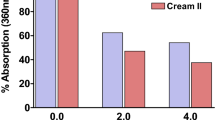Abstract
The goal of this study is to investigate commercially available cosmetics (foundations, skin care creams) which also claim to include a sun protection factor (SPF). Are these products, which are not considered sunscreen products, helpful or could they be harmful? Using an in vitro method, we tested the effectiveness of 35 commercially available products against UVB and UVA radiation. For each product, our testing focused on determining the following four values in terms of current legal recommendations: SPF, UVA protection factor (PF-UVA), UVB/UVA ratio and critical wavelength (λc). We also tested each product’s level of photostability. Effectively, when considering instructions for use (skincare products are applied once, in the morning) any product displaying an SPF must be particularly photostable, since its labeling does not indicate reapplication. In contrast, the packaging on sunscreen products clearly indicates the necessity of frequent reapplication. Out of the 35 products we tested, seven do not comply with legislation regarding sunscreen products. This non-compliance translates into insufficient protection against UVA radiation. The products sold in pharmacies did comply. In terms of photostability, only eight products out of the original 35 proved to be sufficiently photostable. It would seem inappropriate to use filters in the formulas of non-sunscreen cosmetics.
Similar content being viewed by others
References
Alami-El Bourry S, Couteau C, Boulande L, Paparis E, Coiffard LJM (2007) Effect of the combination of organic and inorganic filters on the sun protection factor (SPF) determined by in vitro method. Int J Pharm 340:1–5
Chatelain E, Gabard B (2001) Photostabilization of butyl methoxydibenzoylmethane (Avobenzone) and ethylhexyl methoxycinnamate by bis-ethylhexyloxyphenol methoxyphenyl triazine (Tinosorb S), a new UV broadband filter. Photochem Photobiol 74(3):401–406
Couteau C, Pommier M, Paparis E, Coiffard LJM (2007) Study of the efficacy of 18 sun filters authorized in European Union tested in vitro. Pharmazie 62:449–452
Couteau C, Faure A, Fortin J, Paparis E, Coiffard LJM (2007) Study of the photostability of 18 sunscreens in creams by measuring the SPF in vitro. J Pharm Biomed Anal 44:270–273
Diffey BL, Robson J (1989) A new substrate to measure sunscreen protection factors throughout the ultraviolet spectrum. J Soc Cosmet Chem 40:127–133
European Commission (2006) Recommendation on the efficacy of sunscreen products and the claims made relating thereto. Official Journal of the European Union L265/39, 2006/7647/EC, pp 39–43
Farmer KC, Naylor MF (1996) Sun exposure, sunscreens, and skin cancer prevention: a year-round concern. Ann Pharmacother 30:662–673
Ferrero L, Pissavini M, Marguerie S, Zastrow L (2003) In vitro determination of sun protection factor. J Cosmet Sci 54:463–466
Kligman L (1989) Photoaging: manifestations, prevention, and treatment. Clin Geriatr Med 5:235–251
Krutman J (2000) Ultraviolet A radiation-induced biological effects in human skin: relevance for photoaging and photodermatosis. J Dermatol Sci 23:S22–S26
Meunier L (2003) Photoprotection de la cellule de Langherans. In: Schmitt D (ed) La cellule de Langherans humaine. Inserm, Paris, pp 267–278
Rabe JH, Mamelak AJ, McElgunn PJS, Morison WL, Sauder DN (2006) Photoaging: mechanisms and repair. J Am Acad Dermatol 55:1–19
Schauder S, Ippen H (1997) Contact and photocontact sensitivity to sunscreens: review of a 15-year experience and of the literature. Contact Derm 37:221–232
Schlumpf M, Cotton B, Conscience M, Haller V, Steinmann B, Lichensteinger W (2001) In vitro and in vivo estrogenicity of UV screens. Environ Health Perspect 109:239–244
Vanquerp V, Rodriguez C, Coiffard C, Coiffard LJM (1999) High-performance liquid chromatographic method for the comparison of the photostability of five sunscreen agents. J Chromatogr A 832:273–277
Wlaschek M, Tantcheva-Poor I, Naderi L, Ma W, Schneider LA, Razi-Wolf Z (2001) Solar UV irradiation and dermal photoaging. J Photochem Photobiol B 63:41–51
Author information
Authors and Affiliations
Corresponding author
Rights and permissions
About this article
Cite this article
Séhédic, D., Hardy-Boismartel, A., Couteau, C. et al. Are cosmetic products which include an SPF appropriate for daily use?. Arch Dermatol Res 301, 603–608 (2009). https://doi.org/10.1007/s00403-009-0974-2
Received:
Revised:
Accepted:
Published:
Issue Date:
DOI: https://doi.org/10.1007/s00403-009-0974-2




